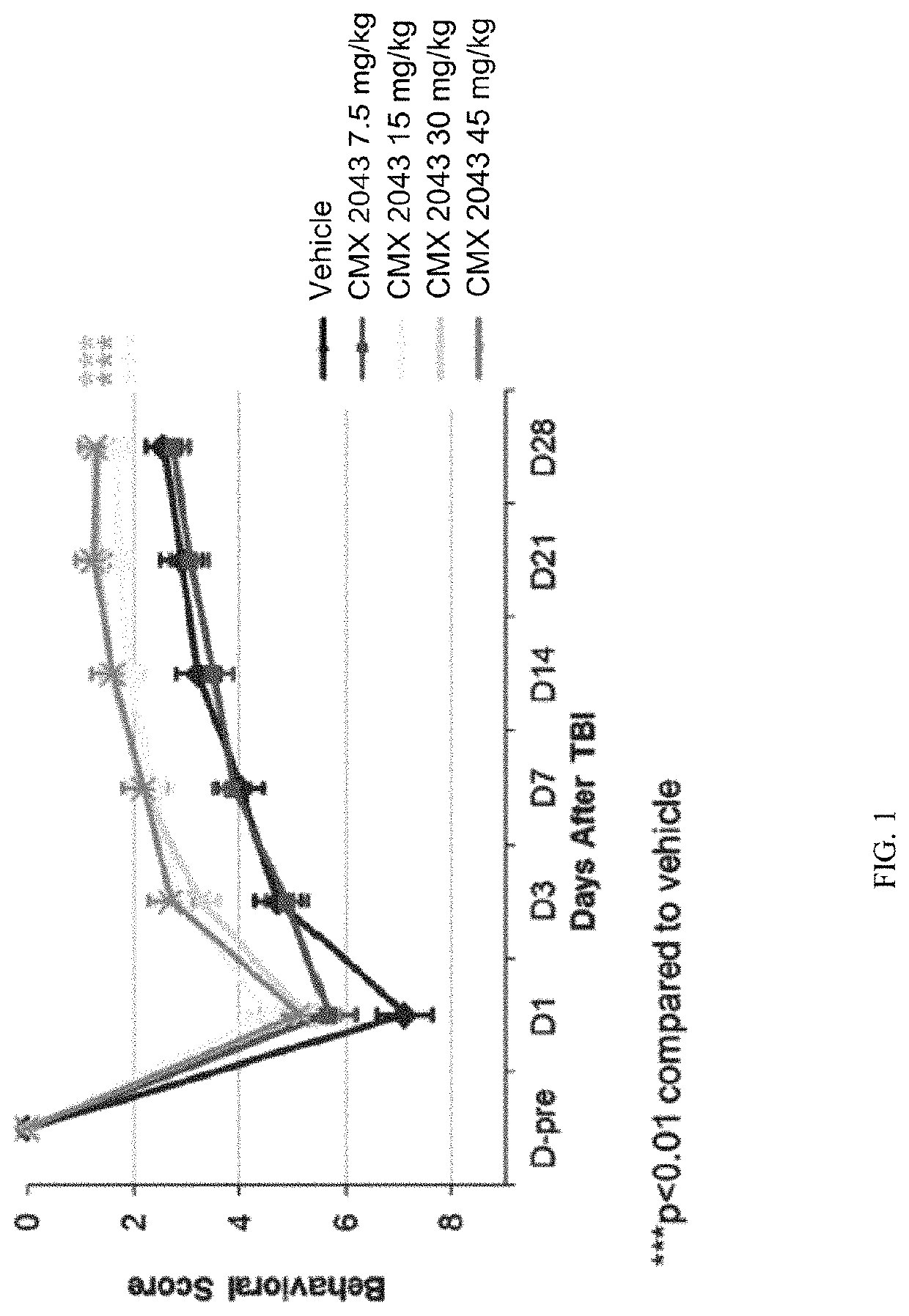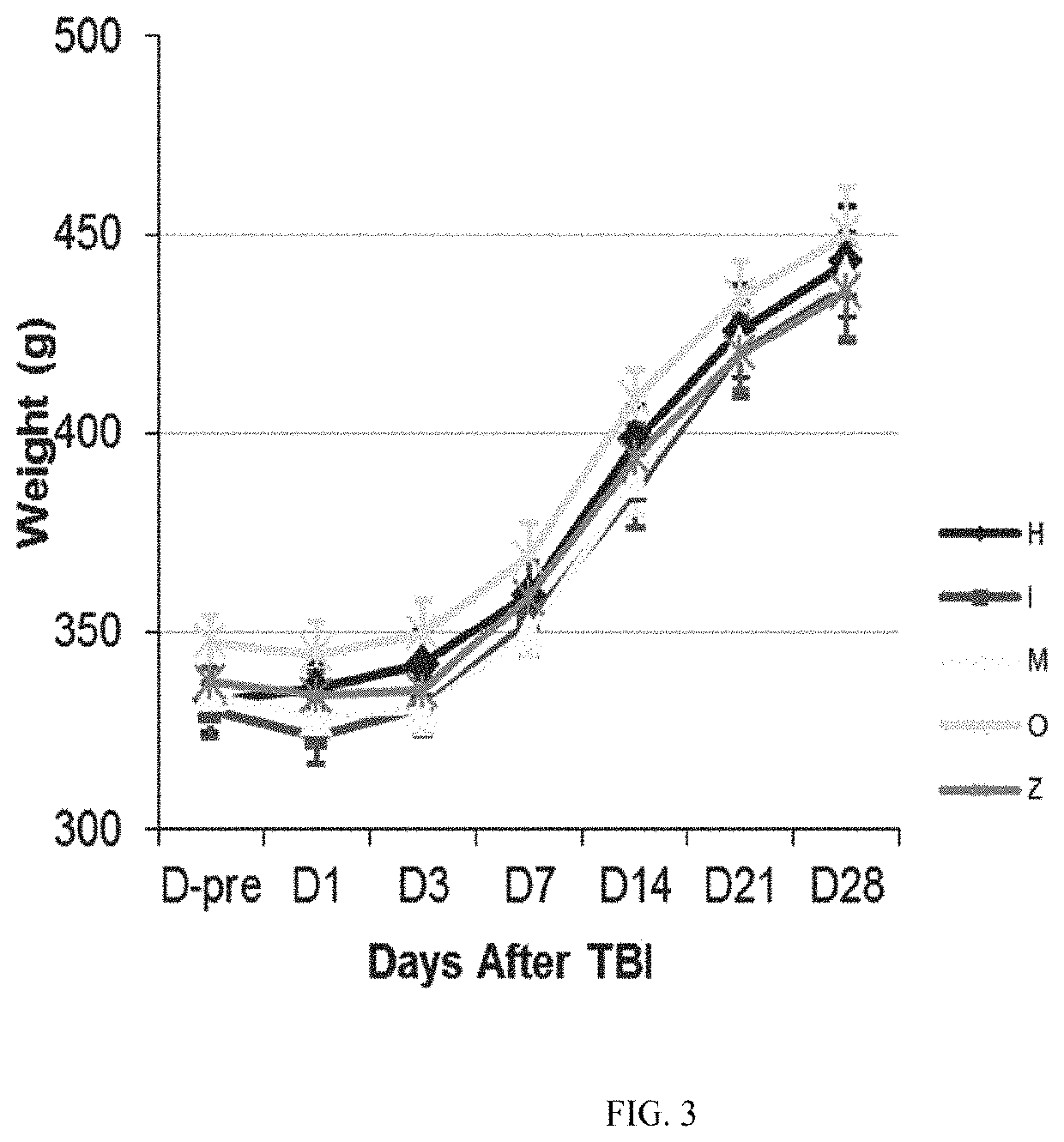Compositions and methods for treating traumatic brain injury
a technology of brain injury and composition, applied in the field of compositions and methods for treating traumatic brain injury, can solve the problems of secondary brain damage, open head or closed head injury, and brain damage, and achieve the effect of improving long-term functional outcomes
- Summary
- Abstract
- Description
- Claims
- Application Information
AI Technical Summary
Benefits of technology
Problems solved by technology
Method used
Image
Examples
example 1
of CMX-2043 in a Fluid Percussion Model of Diffused Traumatic Brain Injury (TBI) in Rats
Procedures
[0189]On the day before TBI surgery (Day −1), rats were anesthetized with 3% isoflurane in a mixture of nitrous oxide and oxygen (2:1) for induction of anesthesia and then maintained at 1-3% isoflurane in a mixture of nitrous oxide and oxygen (2:1). The surgical site skin was shaved, and the rat was then placed in a stereotaxic frame. Buprenorphine SR, s.c, (0.9-1.2 mg / kg Zoopharm: Lot: BSR1-142111) and Cefazolin, i.p., (40-50 mg / kg; Hospira: Lot: 101D032) was given at this time. The skull was exposed through a midline incision. A parasagittal craniotomy (5 mm) using a trephine drill was performed at 1 mm posterior to bregma and 1 mm lateral to the midline (outer circumference). A sterile plastic injury tube (the plastic connector hub of a sterile needle cut 1 cm in length and trimmed to fill the craniotomy securely) was placed over the exposed dura and bonded by super glue to the skull...
example 2
n of Efficacy of CMX-2043 and CMX-26394 in the Morris Water Maze Tests in a Rat Model of Focal TBI
Animals
[0206]Adult, male, Spague-Dawley rats from Charles River were used. Animals were received at PsychoGenics and assigned unique identification numbers (tails marked). Animals were housed 2 per cage in polycarbonate rat cages equipped with microisolators and acclimated for up to 7 days. All rats were examined, handled, and weighed prior to initiation of the study to assure adequate health and suitability. During the course of the study, 12 / 12 light / dark cycles were maintained. The room temperature was maintained between 20 and 23° C. with a relative humidity maintained around 50%. Chow and water were provided ad libitum for the duration of the study. Animals were randomly assigned across treatment groups.
Bilateral Controlled Cortical Impact (BCCI) Traumatic Brain Injury (TBI)
[0207]BCCI TBI to the medial frontal cortex (MFC) was induced by a cortical contusion device (Custom Design &...
example 3
Improves Outcomes Following Focal Traumatic Brain Injury in a Porcine Model
[0232]A study was designed to test whether CMX-2043 administration following focal traumatic brain injury would limit reductions in mitochondrial bioenergetics, mitochondrial reactive oxygen species generation (mtROS), and oxidative injury 24 hours post-TBI.
[0233]Study Design: A blinded, placebo controlled proof of concept trial of CMX-2043 was conducted in four-week-old piglets (8-10 kg). Piglets at this age have comparable neurodevelopment to a human toddler. Sixteen piglets (n=16) were designated into three cohorts: 1) Controlled cortical impact (CCI) at the rostral gyrus treated with a bolus of CMX-2043 (n=5), 2) CCI injured animals treated with placebo (n=5) and 3) sham animals (n=6). CMX-2043 treated animals received an intravenous loading bolus of CMX-2043 (13.4 mg / kg) 1 hour post-TBI and a 4.5 mg / kg bolus at 13 hours post-TBI. Subjects were intubated, ventilated and anesthesia maintained on isoflurane...
PUM
| Property | Measurement | Unit |
|---|---|---|
| mole fraction | aaaaa | aaaaa |
| length | aaaaa | aaaaa |
| temperature | aaaaa | aaaaa |
Abstract
Description
Claims
Application Information
 Login to View More
Login to View More - R&D
- Intellectual Property
- Life Sciences
- Materials
- Tech Scout
- Unparalleled Data Quality
- Higher Quality Content
- 60% Fewer Hallucinations
Browse by: Latest US Patents, China's latest patents, Technical Efficacy Thesaurus, Application Domain, Technology Topic, Popular Technical Reports.
© 2025 PatSnap. All rights reserved.Legal|Privacy policy|Modern Slavery Act Transparency Statement|Sitemap|About US| Contact US: help@patsnap.com



